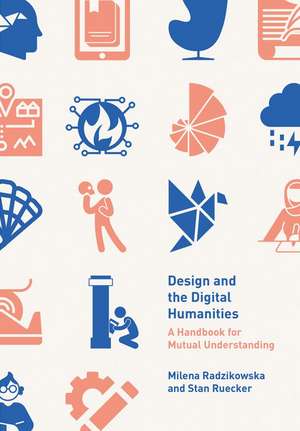Design and the Digital Humanities: A Handbook for Mutual Understanding
Editat de Milena Radzikowska, Stan Rueckeren Limba Engleză Paperback – 3 mai 2022
Drawing on more than twenty years of experience, this book will prepare professionals from both fields to work together. Milena Radzikowska and Stan Ruecker outline disciplinary perspectives, share common pitfalls to avoid, and break down foundational concepts from both disciplines. With illustrated case studies from cutting-edge research projects, supplementary reading lists, and dozens of practical exercises, this is an essential, accessible handbook that will bring design and the digital humanities closer to mutual understanding.
Preț: 249.53 lei
Preț vechi: 311.91 lei
-20% Nou
Puncte Express: 374
Preț estimativ în valută:
47.75€ • 49.99$ • 39.51£
47.75€ • 49.99$ • 39.51£
Carte disponibilă
Livrare economică 15-29 martie
Livrare express 01-07 martie pentru 32.82 lei
Preluare comenzi: 021 569.72.76
Specificații
ISBN-13: 9781789383584
ISBN-10: 1789383587
Pagini: 272
Dimensiuni: 170 x 244 x 20 mm
Greutate: 0.5 kg
Editura: Intellect Ltd
Colecția Intellect Ltd
ISBN-10: 1789383587
Pagini: 272
Dimensiuni: 170 x 244 x 20 mm
Greutate: 0.5 kg
Editura: Intellect Ltd
Colecția Intellect Ltd
Notă biografică
Milena Radzikowska is professor of information design at Mount Royal University in Calgary, Alberta, Canada. Stan Ruecker is the Anthony J. Petullo Professor of Design at the University of Illinois at Urbana–Champaign. Together, they are the coauthors of several books, including Prototyping Across the Disciplines: Designing Better Futures, also published by Intellect.
Cuprins
Introduction
- Selling the Value of Design
- The Epistemological Modes of Knowledge Production
- Change is scary
- i) Territory of Possible Engagements
- ii) Moving the Goalposts
- What expertise looks like
- i) Who are Designers?
- ii) Who are the Digital Humanists?
- iii) What Expertise in Collaboration Looks Like
- EXERCISES: Meaning
- Creating understanding
- Defining DH
- i) What do Digital Humanists Do?
- Defining design
- i) Is There Such Thing As Good Design? If So, What Is It?
- ii) Why Design Matters
- Defining DH
- iii) Critical Design
- iv) What do Designers Do?
- What is Publishable
- Case study 1: how design students define themselves
- EXERCISES: Form and text
- Misunderstandings
- Terms from DH
- i) Text Encoding
- ii) Structured Data
- Terms from DH
- iii) Federated Data
- iv) Linked Data: A Brief Historical Foray into the Memex
- Terms from Design
- i) Sketches
- Types of sketches
- ii) Three Forms of User-Centered Design
- i) Sketches
- iii) Design Thinking
- iv) Reframing
- v) Gestalt
- Claim Games
- i) Research
- ii) Projects and Research Projects
- iii) Image
- iv) Text
- v) Prototypes
- vi) Metaphors and Other Figures of Speech
- vii) Iteration
- Case study: what's a book?
- EXERCISES: Collections and territories
- Meeting points
- Humanities visualization
- i) Why Graphical Representation?
- ii) Rich Prospect Browsing
- Humanities visualization
- iii) Proposing New RPB Principles and Tools
- Principle of Participation
- Principle of Association
- Principle of Contexuality
- Principle of Pluralism
- iv) A Critical Challenge to the Power Embedded in Prospect and Refuge
- Case studies: DH-based visualizations created by undergraduate design students
- i) BigSee
- ii) Structured Surfaces
- iii) Results
- iv) What We’d Change
- Case studies: Decision Support Systems
- i) Descriptive Reflections
- ii) Design Z (Gears)
- iii) Design A+1 (Bars & Sliders)
- iv) Design B (Lines & Dots)
- v) Analytical Reflection
- vi) Feminist RPB in Manufacturing DSS
- vii) Critical Reflection Using Feminist HCI
- viii) Reflection Using a Critical Design Framework
- EXERCISES: Data visualization and interface design
- Working better together: interdisciplinary research in practice
- Developing interdisciplinary researchers
- i) Undergraduate Interdisciplinary Researchers
- ii) Masters-Level Interdisciplinary Researchers
- Developing interdisciplinary researchers
- iii) PhD-Level Interdisciplinary Researchers
- iv) Resource Needs
- v) Critical Non-Tangibles
- What is Respectable?
- Project management for interdisciplinary researchers
- i) Ways of Collaborating
- ii) Delegation vs Collaboration
- iii) Cross Disciplinary Lessons Learned
- Managing people who are sensitive to their surroundings
- i) Designers as Paramecium
- Tenacity, or Sticking it Out
- Repetition: Same Shit, Different Pile
- Comparison: One Person’s Poison is Another Person’s Nutrient
- Community: A World of Paramecia
- Changing the World
- From Bad to Worse: What if the Choice is Between Greater Poison and Lesser Poison?
- From Good to Better: Choosing Among Nutrients
- Discontinuity, or Sudden Death
- Unanticipated Side-Effects
- Reality Check: Taking a Few Roughs with a Smooth
- Case study: Interdisciplinary research project charter
- i) The Project Charter
- ii) Most Recent Additions and Considerations
- EXERCISES: Planning
- i) Designers as Paramecium
- Our Journey Continues
- From the Digital to the Physical
- Design for Peace and Reconciliation
- Collaborative
- Design Concepts Lab
- Final thoughts
- EXERCISES: Intellectual territories








